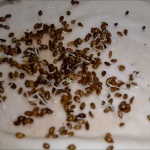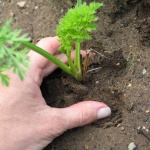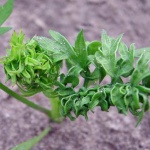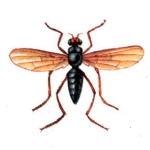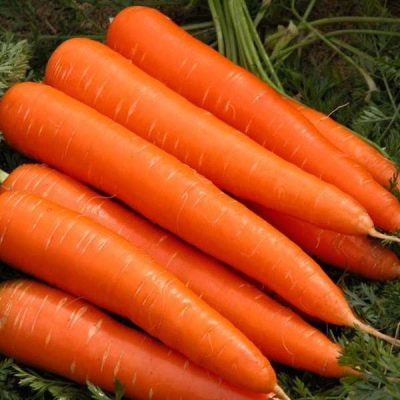
- Authors: Zhidkova N.I., Kvasnikov B.V., Belik T.A.
- Year of approval: 1964
- Appointment: for fresh consumption, for canning, for freezing, for bundled products, for making juice
- Weight, g: 140-170
- The form : cylindrical
- Taste qualities: excellent
- Ripening terms: mid-season
- Growing regions: North-West, Central, Volgo-Vyatka, TsChO, North Caucasian, Middle Volga, West Siberian, Far East
- Length, cm: 15-17
- Bark coloration: orange
For more than half a century, Losinoostrovskaya 13 carrots have been considered one of the best domestic varieties. The root crop belongs to the Berlikum-Nantes cultivar. It stands out not only for its aligned orange fruits, but also for its rich composition of nutrients.
Breeding history
The culture is a prominent representative of domestic selection. Work on the variety was carried out at the Federal Scientific Center for Vegetable Growing at the end of the 50s of the XX century. The authors of the culture, breeders Zhidkova N., Kvasnikov B., Belik T. received it by crossing, as well as selecting the best specimens of such carrot varieties as Nantes, Touchon, Amsterdam. The application for registration was filed in 1960. After successful variety trials 4 years later, in 1964, the Losinoostrovskaya 13 variety was included in the State Register of the Russian Federation.
Description of the variety
Losinoostrovskaya 13 is a proven carrot variety, and many gardeners trust him. One of the features of the culture is that in the place where the root crop is fused with the tops, there is no greenish circle characteristic of most other varieties. This happens because during the growth period the carrots are entirely in the ground.
Characteristics of the appearance of the plant and root crops
The carrot variety Losinoostrovskaya 13 differs in that it has aligned cylindrical roots, which most often have the same diameter along the entire length (32–42 mm). The tip of the carrot has a rounded or pointed shape. In length, the root crop grows to 15-17 cm. The average weight is 140-170 g. The color of both the pulp and the core is orange.
The carrot tops of the variety are straight, but can be spread out to the sides, the height of the leaves is 35–40 cm. The number of rosette leaves is 13 (according to one version, this fact served as the impetus for the choice of the name), but sometimes there are 11. The contours of the leaves are heavily indented, leaf with petiole is almost the same size. The tops are painted in an intense green color.
Purpose and taste of tubers
Losinoostrovskaya 13 is used both fresh and for canning, freezing, carrot juice is prepared from it, the product is also excellent for processing in puree for baby food, which turns out to be quite sweet even without added sugar. And also many people cook dried carrots in the oven, which is an excellent natural delicacy.
Maturation
The mid-ripening carrot Losinoostrovskaya 13 ripens in a period of 80 to 110 days.
Yield
The average yield of the described carrot variety is quite high, they amount to 6–8 kg / m 2.
Growing regions
The cultivation of Losinoostrovskaya 13 carrots is recommended for the European part of Russia, excluding the south, as well as for Siberia, Transbaikalia, and the Far Eastern region.
Growing and care
The seeds of Losinoostrovskaya 13 can be planted equally successfully both in early May and before winter, in October. Frosts, if they are not strong, will not damage the seedlings. If sowing takes place in the spring, it is carried out in the grooves, the planting depth is 1-2 cm, between the holes 3-4 cm. The grooves are made with a distance of 15-20 cm.
A particularly good soil that is suitable for growing this variety of carrots will be loam or sandy loam. Moreover, it must be well aerated.
Caring for carrot crops of this culture consists of a number of activities: loosening row spacings, weeding, regular irrigation, fertilizing with mineral fertilizers, preventing diseases and attacks of insect pests. You should not take humus as a dressing for carrots, this can cause branching of root crops.
At the same time, watering should be fairly moderate, this will prevent cracking of the carrots. And also for this variety it is necessary to perform thinning, that is, the removal of some part of the seedlings planted too densely. If you do not thin out, roots that grow at a distance of less than 1.5 cm will intertwine, interfere with each other's growth, and also deform.
Another obligatory care technique is that hilling should be done several times during the growing season, the root crop should not be exposed. And to keep moisture in the ground, the beds are mulched with humus or non-acidic peat.
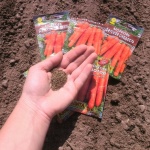
Carrots are one of the most unpretentious crops in terms of growing conditions; they can endure a short drought and a short cold snap. However, to get tasty and large root crops, you should adhere to the basic rules for planting carrots.
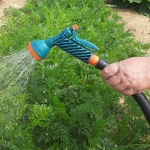

Disease and pest resistance
Thanks to the labor of breeders, Losinoostrovskaya 13 has immunity to most diseases typical for umbrella crops. And also the culture is resistant to blooming, adapts well to sudden cold snaps.
Nevertheless, the carrots of the variety in question still sometimes suffer from white and gray rot, and can undergo bacteriosis and phomosis. Some pests, for example, carrot flies, scoops, slugs, aphids, also annoy the crop. To prevent carrot fly attacks, you can make beds next to carrots with green onions on one side and garlic on the other. And also to prevent diseases, it is necessary to observe the correct conditions for crop rotation and agricultural technology.

Carrots grow in almost any garden. There is an opinion that this culture is very resistant to all kinds of diseases and pests, but this is not the case. Without proper care, carrots become susceptible to all kinds of infections and are affected by harmful insects.


